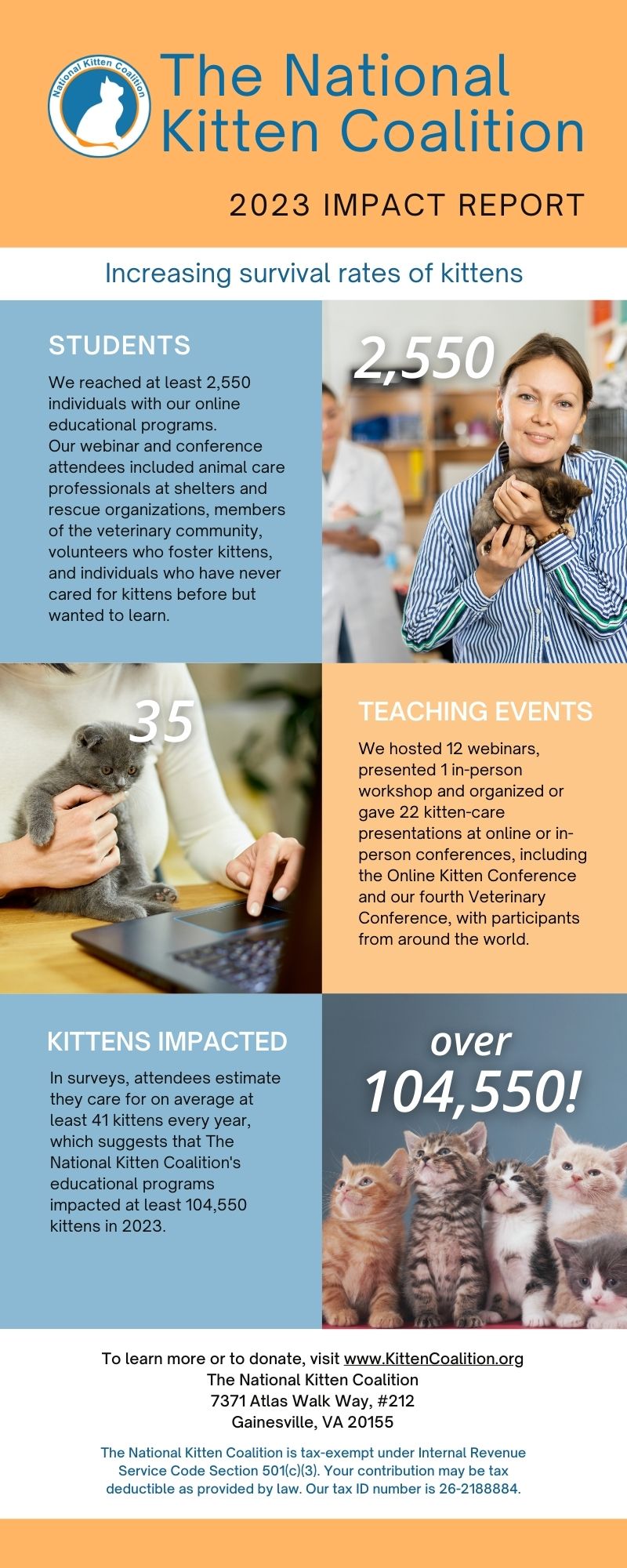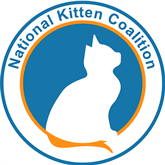In 2023, at least 2,500 kittens benefited from our life-saving information!

Other Data
There is no central data reporting system for animal shelters and rescue organizations in the United States, and many states do not require reporting (note: many organizations also do not breakdown their cat statistics into adult versus kitten). Therefore, many national animal welfare organizations do their best to estimate numbers. We have included some of these organizations and their estimates below.
- In 2022, 2.9 million companion animals entered animal shelters nationwide (net intakes, excluding double counting from transfers from other shelters).
- Of these, 1.4 million (48%) were cats in 2022.
- In 2022, of the (non-transferred) cat intakes for which age was known, 38% were kittens (defined as cats aged five months or less).
- 82% of these kittens were adopted.
- 11% of these kittens died in care or were euthanized.
The Humane Society of the United States estimates the following:
- Number of brick-and-mortar animal shelters in the US: 3,500
- Number of rescue groups and animal sanctuaries in North America: 10,000
- Number of cats and dogs entering shelters each year: 6-8 million (down from 13 million in 1973)
- Of the 3 million cats and dogs euthanized in shelters each year, approximately 2.4 million (80%) are healthy and treatable and could have been adopted into new homes
- Number cats and dogs adopted from shelters each year: 4 million
- Percentage of cats euthanized in shelters: 70%
- Percentage of total shelter intake comprised of cats: Approximately 50% (in some regions, 2/3 of a shelter’s population is cats)
The American Society for the Prevention of Cruelty to Animals offers the following statistics:
- Approximately 7.6 million companion animals enter animal shelters nationwide every year. Of those, approximately 3.4 million are cats.
- Each year, approximately 2.7 million animals are euthanized (1.4 million cats).
- Approximately 2.7 million shelter animals are adopted each year (1.3 million cats).
- About 649,000 animals who enter shelters as strays are returned to their owners. Of those, only 100,000 are cats.
- Of the cats entering shelters, approximately 37% are adopted, 41% are euthanized, and less than 5% of cats who came in as strays are returned to their owners.
The National Kitten Coalition’s mission is to increase kitten survival rates and transform their lives through the power of education. We know that many animal shelters do not have the resources and/or knowledge to care for neonatal kittens in particular; therefore, we believe neonatal kittens or “bottle babies” are one of the most vulnerable populations in many animal shelters and are subsequently euthanized. Our vision is that all neonatal, sick and other at-risk kittens are given a chance to grow and thrive through life-saving educational programs and positive partnerships among shelters, rescues, veterinarians and the public. We want to partner with shelters and rescues and help these front-line animal heroes with their life-saving efforts. We know that education, training, outreach and information sharing will move us closer to our vision for the future and are proud to stand shoulder-to-shoulder with shelter and rescue staff and volunteers as we work to reduce euthanasia in kitten populations across the United States.
Note: Spaying and neutering is important! Remember a female cat can produce three litters in one year, and the average number of kittens in a litter is four to six.
